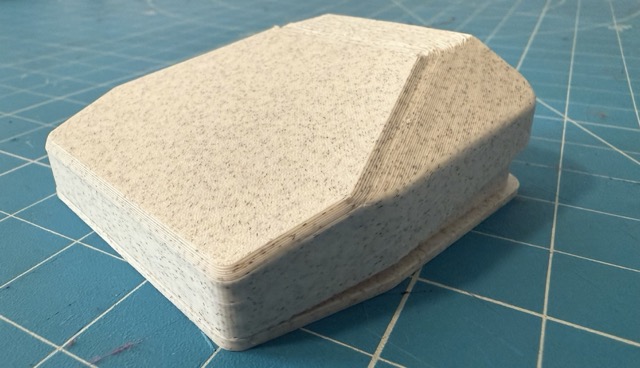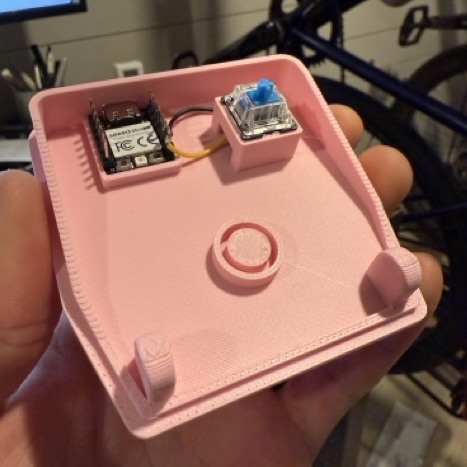Footy Foot Pedal
Jan 2025 - Apr 2025Footy is a 3D printed foot pedal for your computer. Pair it with a speech-to-text app and suddenly you've got a unique way to compute using your feet.
I made Footy while I had a broken finger and my right hand was in a cast. I certainly consider Footy to be an accessibility device, but I think it can really be used by anyone who wants to use their computer differently. There's something hilarious yet satisfying about using your computer with your feet. I'm excited to show you how to build your own Footy so you can stick your foot in your mouth too. Oh wait, maybe remove the foot from your mouth. Don't be shy, let's get into it

tldr: its a foot pedal. watch a video
Background
I broke my finger on January 2nd and was put into a cast soon after they 'realigned' my finger. As soon as I had broken my finger, I was using speech or text all of the time on my Mac. But it was quite uncomfortable/painful to use with a broken finger so I started thinking about ways in which I could trigger speech to text without needing my hand or fingers. A foot pedal became immediately obvious as a solution.
I checked Amazon for computer foot pedals, but found only USB-A options (unacceptable). With this I decided to make my own, and Footy was born.
Requirements
With some background in mechanical keyboards and their firmware, I figured the most straightforward approach would be to build what's essentially a one-key keyboard for your foot. My requirements quickly shaped up to be:
- USB-C Connector
- QMK Firmware
- Some RP2040 based microcontroller
- 3D Printed Case
- Cherry MX Switch
- Open Source Hardware/Software
- Replicable for others
MOST OF ALL IT HAS TO BE FUN
Prototype
I needed to decide on two key components: the microcontroller and the case. After a little bit of looking around I decided on the Seeed Studio XIAO RP2040 for the microcontroller as it was cheap, tiny, and had a built in USB-C connector. For the case I browsed around for quite a while, and eventually found this Adafruit project for a foot pedal which I used as the foundation for my design.
After some minor hacking on the case and initial QMK firmware, I had a working prototype. Here's what it looked like before I accidentally destroyed it by using CA glue:

You can check out more details about the prototype on this dumpster page.
V1
While the prototype worked, it was janky and too handwired for my taste. I wanted something a bit easier for someone else to make if they wanted. Basically, all I wanted was a Cherry MX switch to be on the same PCB as the RP2040 microcontroller. I thought a little about making a custom PCB, but discovered the Stampy microcontroller which seemed very well suited to this project. Plus, its name was just perfect. I was going to be putting a Stampy into my Footy and I would be stamping on my Footy.
3D Printable Case
I modified the Adafruit foot pedal design for the Stampy. I adding heat set inserts to the base
for secure mounting, and a larger rectangle on top for better switch actuation.
All customizations were done in Autodesk Fusion, and you can find both .stl
files for printing and .f3d files for modification on
Makerworld.
QMK + VIA Firmware
I wrote QMK firmware for Footy along with a VIA profile to make it easily customizable. QMK is firmware for keyboards, and VIA makes it easy to change keymaps and other things. The firmware primarily targets the center switch on the Stampy.
The main thing for it was to get my key binding for handy or superwhisper to be the default.
I have an open PR in the QMK repo for the Footy firmware. Once merged, I'll submit a PR to VIA so Footy gets official support there as well.
Build Guide
Building your own Footy is easy
Steps
- Download and 3D print the case (or email me, I can print you one)
- Download and flash the firmware on the Stampy
- Put the Stampy in the Footy
- Plug it in and start computing with your feet!
Materials Needed
- (1x) Footy Case
- (1x) Stampy Microcontroller
- (1x) Cherry MX Switch (ideally with 3 and not 5 legs)
- optional: (2x) M3x4mm - Heat Set Inserts
- optional: (2x) M3x6mm - Screws
Flashing the Firmware
You can find the QMK/VIA enabled firmware here:
- Footy Default Keymap (triggers the
bkey) - Footy Handy Keymap (triggers
RCTL + RGUIwhile held down) - Footy Superwhisper Keymap (triggers
LOPT + SPACEwhile held down) - via.json
You can flash the firmware on the Stampy by plugging it into your computer and double clicking the button on it.
This will load the Stampy into it's bootloader. From here, drag and drop the .uf2 file of your
choosing onto the drive that appears on your computer's file explorer. The Stampy will reboot, and it should turn into a working Footy.
Using Footy
It's funny how you become accustomed to a thing without even realizing it. You only realize when it's gone. I always have this realization when I'm on the couch and not at my desk. And all of a sudden I want to speak to my computer, but don't have my Footy to do so.
It's interesting because I also have speech to text buttons on my desk, yet Footy is my go-to. I think maybe it's because when I have my hands on a keyboard, I naturally want to type. But my feet have no such inclination.
Footy gets a lot of use for me when I'm at my desk programming, emailing, sending messages, or talking to large language models to aid in all these things.
I wrote most of this post using my voice. I love using my voice for something like this. There are times at which the syntactic preciseness of typing is important, but I find I like to think and converse with my voice more than I do through writing. I'm curious in the future to try to write even more conversationally as a result. This post largely has a format of a blog post, but I am interested in what a non-linear conversation may look like too.
Looking Forward
This was a super fun project and important for me. It honestly made a huge difference in my life for a time. While I had the cast on, Footy was truly invaluable. Before Footy was created, working on the computer was extremely annoying, if not painful. I couldn't sit at my desk for more than an hour at a time. With Footy I could be simulataneously more relaxed and productive.
I also wrote my own custom speech-to-text application called Handy during this time, which I'll be sharing more about soon. It's gonna be a fully open source desktop application.
I also want to do a larger reflection on using speech-to-text and how computing with your voice dramatically changes the way you interact with a computer. In some ways it is a glimpse into the future, yet we are still hunched over glowing attention sucking rectangles. shiny